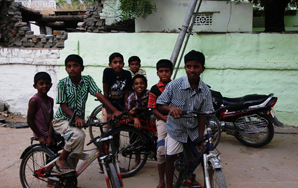A Disappearing Lifestyle: Two Weeks In An Indian Village

Almost every Indian has a village they can be traced back to. This is true whether they were born in the countryside or in the chaos of a Bombay traffic jam. Huge chunks of the population still live in rural farming towns, hamlets with a few dusty lanes, some ambling livestock, and the promise of back-wrenching work at sunup. But all across India, the traditional farming village is disappearing. They are emptying –– becoming like the shells of forgotten towns one sees dotted around France and across the European countryside. Places where the elderly peer from the stoops of their worn-out porches, and crumbling, one-room schoolhouses serve as ghostly reminders of a time before kids moved away for boarding schools. What took Europe a hundred years, and America fifty, is happening to India within the span of a single generation. In India, you can literally watch globalization. The young are migrating en masse from the farming communities to the cities, looking for work, for opportunity, simply to move up. This is happening with special haste in Andhra Pradesh, the heartland of India’s cotton industry. Here, a dependence on cotton has forced many farmers to acknowledge that their staple crop can no longer support their families, their lifestyles, or their ambitions to join India’s rising middle class.
Andhra Pradesh is a state located just below the midpoint of the subcontinent. It is India’s own version of the Great Plains, its flat expanses stretching out to the horizon line in every direction with the dull greens and muddy browns of cultivated fields. There are seemingly endless fields. We were there in mid October doing a pan-India bicycle tour, pedaling our way north from Bangalore to a small farming hamlet where we had been invited to stay with a friend’s uncle.
“Just follow the church towers,” we had been told. Sure enough, Brahmanapally was easy to spot from a distance. Its two pink church towers were the tallest thing in sight, only a few palm trees to compete with. It is a town tucked miles off the main highways, split up into two mini villages –- Old and New; one Hindu and one Catholic. The two clusters of homes are separated by one bridge and more than a few cultural antagonisms. We were staying in the Catholic side of town, the “New.” Our host was the priest.
Father Raja and his village had been expecting our arrival and were excited for it. It is not common for Americans to visit such a rural part of India. The region is far removed from India’s tourist belts of fancy hotels and agency-approved restaurants; there is no A/C and the mosquitos come in droves. Brahmanapally is a place of real struggle, a town in transition, where a dependence on cotton has hit people hard. Everyone there knows their farming days are numbered, and the hardship showed upon the faces of those who gathered to welcome us at the church. Each member of the parish was facing his or her own struggles in yet another year with King Cotton failing to bring in a profit.
Mereddy Duggimpudi is one such farmer. He hasn’t had a positive balance in his bank account since 1992. With his wife and grown son’s family beside him, and a backdrop of his latest cotton harvest heaped in fluffy white mounds at the side of his porch, Mereddy explained why it’s been so difficult for him to come out ahead. “Every year I have to take out another loan.”
Like most cotton farmers in Brahmanapally, Mereddy doesn’t have enough surplus capital at the beginning of the April planting season to cover all the costs associated with cotton production. Before the time he can sell to the ginning mills each November, Mereddy must account for seven months of buying seed, fertilizers, pesticides, and paying off day laborer and transportation costs. So he takes out two separate loans every year. One of them covers his farming costs, the other is so his family has enough to eat. The Duggimpudis manage to scrape by on just 10,000 rupees ($200) a month.
“I’m lucky my relatives let me borrow from them at 18% interest,” he said.
Lucky indeed. Many other farmers we spoke with said they were obtaining their loans at an alarmingly high interest rate of 36%. They feel as if they have no choice. Over the past five years, they have all been squeezed by the international market into buying genetically modified BT cotton seeds, as well as expensive pesticides and fertizilers designed by large agrifirms in Europe and the United States. The use of GMO cotton has increased traditional yields fivefold, but has reduced raw cotton prices so dramatically that it hardly makes a difference. The higher yields have had the cascading effect of requiring more day laborers to pick the cotton, and additional transportation fees to move it all to the ginning mills.
“Still, cotton is the only way to rise up,” Mereddy said.
He acknowledges that sizable profits can still be made, but that it all depends on the farmer’s appetite for risk and reward. The best way to get ahead is to lease additional land for the season. But leases require additional loans, and how those investments play out all depends on factors well outside the farmer’s control. Namely, cotton prices on the international market, and the weather.
Mereddy chooses to leave the gambling to his neighbors, and instead sticks with what he knows best: the 10 acres of land he owns and has been farming since he inherited them from his father. That decision comes with its own limitations, however. With no risk comes no reward. Every year Mereddy barely manages to pay off his loans. His last bumper crop was decades ago. “Only 20 years ago have I ever seen money with my own eyes,” he lamented. In that year he had used his surplus to buy seven additional acres of land. He had to sell it soon after to pay for his daughter’s dowry.
It’s been a difficult run for the 53-year-old farmer, and the stress of Mereddy’s cotton woes showed. It was only 11a.m. when we went to talk to him, but already his eyes were red and bleary from the bite of cheap country alcohol. As he sat slouched in his chair, we couldn’t help but think of the name we’d heard townspeople calling him behind his back –– “The Drunkard.” It’s hard to escape the gossip in such a small, enclosed community.
Regardless of what people say about him, Mereddy maintains that he’s content with where things are at the moment; he doesn’t mind forgoing a profit if he can continue to support his family. “I don’t want to come up, I don’t want to come down. Things are fine where they are.” He said with a nod towards his son, who stands to inherit the fields from him.
But that land may not be enough to support his son for very long. Life in Brahmanapally is getting more expensive by the year.
The rocketing ascent in the costs—and comforts—of life are visible everywhere in the village. The homes are solid constructions of concrete, many new enough that the pink and orange paints with which they had first been coated remain smooth, abscent any cracks. They have iron gates at their fronts, the mass-produced fancy kind with lots of superfluous decorative twirls, and tall sheds stand beside the porches to store fluffy mountains of the year’s harvest. Inside the homes are gas stoves running off propane bottles, and flat screen TVs that blare soap operas in Telugu (the South-Central Dravidian language spoken here in Andhra Pradesh). The wealthier families even have backup batteries, to keep their lights and fans running when the power goes out. All these luxuries have been purchased largely with the profits of cotton, or at least with the loans taken out against their land, secured by the power of BT seeds, a few years of good rain, and an exploding global culture of consumption that keeps the looms of China humming.
But the biggest expense, the one that has stretched the citizens of Brahmanapally to their knees, are their children. Almost none of them live in the village. King Cotton is working hard to put 95% of them through boarding school in Hyderabad. Most of the families, with red-ink ledgers that cotton could barely keep down, would bet the farm to put their children through a good degree. Some did bet the farm, every year, and they knew how much it hurt to pray as the pickers went out into the field, knowing that they weren’t really collecting cotton, they were collecting the house, and they never wanted their children to have to know that. Debt is the sacrifice made so that the next generation can move up.
The young generation was in town while we were there, back from school for a two-week vacation. We were a source of tremendous interest to them, generators of electric excitement, and the boys took it upon themselves to be our entourage. They travelled in a pack, whose standard of acceptance was being old enough to swing a cricket bat, and ranged in age from 12 to 22. They would wait patiently outside Father Raja’s house for us to come out, and then would crowd around us, each hurtling his own questions. The boys took us out on the village, a 15-strong band of dragoons that introduced us to anyone we passed.
On the streets we met the girls. The girls stayed at home with their mothers, or sat with them on their dusty porches and gossiped with neighbors. There was much to gossip about. Sound carries far in a quiet village, and the sound of the neighbor’s husband popping the top off a Kingfisher foamer could wake even the sleepiest from a nap. Other people’s family matters, like the Mereddy’s, were a favorite topic of discussion. Father Raja had told us that the whole village knew what we were having for dinner every night, courtesy of the cook. Someone had even sought confirmation of the menu.
It was no surprise, then, that our passage with an army of escorts made the streets stop; the women smiling and the men, in a separate group, leaning back and watch us go by. Crowds seemed to gather around whichever porch had arrested us. They asked us questions for a while, but nobody over 25 spoke much English, so the interactions were simple. We often spent meetings just observing one another — they watched us drink our tea, we watched them in the business of their lives.

It was in these groups that the depth of change in the village became apparent. Our escorts and their parents would seem from different worlds were it not for the relation. The parents wore traditional clothing: sarees for women, loin cloths and a collared shirt for men. They had leathery skin from years spent working out in the sun. Our young escorts, however, wore the trendy uniforms of urban youth — khakis and brand-name t-shirts, with skin that was soft and smooth and shiny. The girls, a little more conservative, wore bright, long shirts over thin cotton pants. Both looked out of place on the dusty streets of the village. Some of the boys even had smartphones, which they carried like a badge of honor as they patrolled the village. Others showed off shiny new motorcycles that looked alien next to the roaming buffalo.
When our patrol was over, we retreated back to the church to do some real talking. The boys and the young men who lit up the village with their cries and their cricket games, and the girls and young women who were socially tethered to their porches — these boys and girls had dreams. They were western dreams, white collar dreams, dreams of computer science degrees, dreams with three syllable words like medicine, engineer, IBM and the universal favorite — America! None of them involved cotton. These were kids with whom we could relate, seeing our lives as opportunities to experience fulfillment, passion, and professions that our parents knew little about. These were kids who saw change and wanted a piece of it badly. They had fire in their eyes, backed by thoughts of careers with good salaries and stability. They were Up dreams, dreamt in English, in a language their parents did not understand.
But those dreams came with a price, and it was still their parents who were forced financially onto their knees to make them possible. They would take risks to pay for those dreams, with a house that hung by a thread, knowing just how precarious the situation was. Their children’s education was at the whims of rain and the Mumbai commodity floor.
We saw that stress manifest itself late one evening. After the kids had retreated into their homes for rice dinners, we sat out with Father Raja, swatting mosquitos on his porch. From next door came the sound of yelling. It was a shrill kind of yelling, honest and sustained, and powered by five fingers of whisky and a genuine angst. Father Raja chuckled. “It’s Simon Reddy. He’s yelling about how he took too much land,” he said, and ambled over to the church compound wall to invite Simon over for an interview. Simon trotted over obediently, if a little unwillingly; one does not disobey the village priest. He sat on the bench next to us and waited submissively for our questions.
The farmer was in a tight spot. The cotton fields were his casino, a regular Monte Carlo, and he played for the highest stakes in the village. He had to. Simon had inherited just three acres of land, and bought two more thirteen years ago after a bumper crop. But with Cotton doling out razor-thin margins, five acres isn’t enough to survive, especially with the skyrocketing costs of living. “Now we have so many bills,” he complained. “It used to be that we could farm with just human labor, and gather fire wood for our stove.” Now, Simon has to contend with the costs of gas stoves, a motorcycle, and the soaring price of rice. The greatest expense of all, though, is his daughter’s education in Chemical Technology at the Jesuit College in Hyderabad.
Every year, Simon borrows as much as the loan offices allow him to lease as much land as he can. The strategy paid off two years ago, when good rains returned enough profit to rebuild his house. Last year was a different story. The risks came back to bite him when he rented 30 acres, and all of his land withered under an intense drought, leaving him teetering on the financial edge. He has been able to keep his new house and land only by emptying his savings and by obtaining a few kind extensions from his lenders.
It hasn’t stopped Simon from going all-in again this year; even with the burden of unpaid loans, Simon took out twenty acres.
It was a cliff-hanger of a cotton season. The rains were sparse, and fields all around were turning red with disease. Simon was 400,000 rupees in debt (roughly $8,000), and spent most nights not on the field worrying into bottles of cheap country liquor. The crop pulled through; he will break even, his house and land intact. But only just, and some sliver of his loans may carry through to next year.
The financial difficulties have left Simon exposed. After his disaster of a crop last year, his wife had to move away from home to go work in a nearby children’s hostel to help make ends meet. Another bad season with land leased on loan and Simon is out of the business, homeless, and getting on a bus bound for Hyderabad to go find menial work as a night watchman or a cleaner. It doesn’t seem to have impacted his appetite for risk. “Always I like to take more land,” he said. If interest rates stay the same next April, when the decisions are made before the weather is known, he’ll borrow another 400,000 rupees, and lease another thirty acres. It is as if he’s already accepted his demise, having already spent so much energy on fearing that slow walk to the bus to Hyderabad, laden with the few possessions that he would have left, that he has ceased to care. He has accepted it as a fact of life, and it doesn’t bother him one bit, as long as he can watch his daughter graduate, and avoid the shame of rumors that will circulate like plague when the unpaid lenders plant them.
He puts his priorities simply: “I’d sell my house and my land to keep my daughter in school.” Moving the family up is everything.
Simon is an extreme case, teetering each year on the edge of financial cataclysm. Every April, at the Telugu New Year, each family must finger its chips and decide how much they will wager. Their decisions form a continuous spectrum; some have enough alternate streams of income that the fields are a small investment. All of them, though, have their lifestyles affected by the outcome of the crop. To find out how deeply, one need only open the state newspaper on any given day, to find another 500 words on a farmer who would rather drink a glass full of pesticide than face the shame of the lenders knocking on his door. The trend of farmer suicides has been rocking farming communities across India.
Brahmanapally is just another example of a small village succumbing to the forces of globalization. It is, by all accounts, unexceptional, a fading star amid a galaxy full of them. What is fascinating is how fast things are changing; fifteen years ago this was a place of thatched-roof huts. Now it is a hamlet of concrete homes, occupied by citizens who are giving their children the chance to dream.
The women on the porches in their bright sarees and jingling gold bracelets, the men who have had to turn into agricultural chemists in the past five years to grow their cotton — they know this cannot last. Everybody is in on the secret. They know that their white collar children will, twenty years from now, return to their childhood homes to visit empty streets; almost none will farm the land they inherit. Perhaps even the brightly clad mothers will be gone by then; they will be grandmothers, living with their children in the cities, as per Indian tradition.
As the children leave, one wonders how long it will be before the agriculture industrializes. The cotton business has simply become too risky, its profit margins too thin, to operate with any meaningful income on small plots of land. The crop seems destined for scale and sophistication, for huge picking machines and vast tracts, and suites in skyscrapers hedging and selling with the logic of algorithms. Not for the needs of a small community.
“Twenty years from now, there won’t be more than ten families farming the land,” predicts Father Raja. Or, maybe there will be just one, a family living out of a Hyderabadi mansion. Nobody knows for sure; they only know it probably won’t be them. What we saw in the village was a kind of race, and the current generation knows they cannot win. It’s as if they can hear the clock ticking, counting down to the coming of some mysterious date when too much drought hits or the Chinese find someplace cheaper or the big agri-firms muscle them out; when all their livelihood is suddenly gone, and the only profitable farms will be the corporate ones. The only question is: When?
Until then, everybody is trying to move their family up, to push their children into the middle class, to make the jump from cotton to cubicle. Everyone is reaching for change. As we left the church’s pink towers behind us, we knew that we would never return to find the village streets so bright and noisy. ![]()





